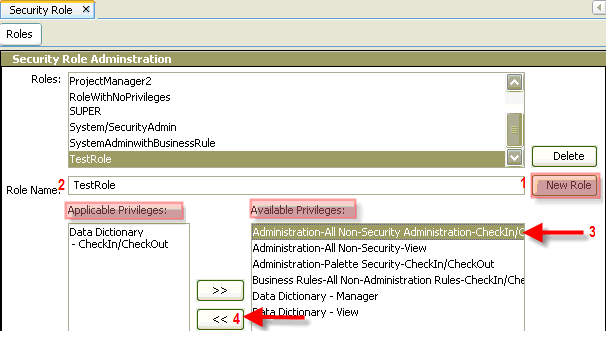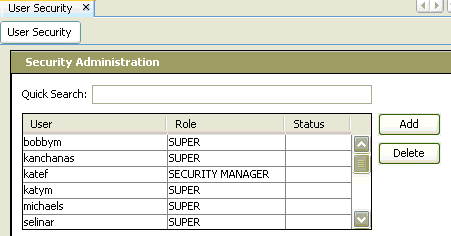Rules Palette Security
The Rules Palette controls all security for both the Rules Palette and for the Oracle Insurance Policy Administration (OIPA) system. The Admin Explorer contains a security folder, which holds security controls for the Rules Palette and OIPA. Only users with Administration Palette Security Check-In/Check-Out privileges will see the security folder.
Palette Security privileges are configured in two steps:
-
User Security: contains a list of all users and the security roles assigned to them.
-
Security Role: contains a list of all security roles and the privileges each role has. These roles are for users performing configuration tasks in the Rules Palette.
The security manager first creates specific
security roles, such as BA, Configuror, Build Manager, etc. These
roles grant users access to the parts of the Rules Palette that pertain
to their specific job functions. Once the roles
are defined, each user can be assigned a security role. Security roles and privileges can be modified
at any time from the User Security or Security Role folder. Modifications
can be made and saved by selecting the Save All ![]() button. This will
save the modifications to the database. In addition, any panes open for configuration with changes
will be saved to the local drive.
button. This will
save the modifications to the database. In addition, any panes open for configuration with changes
will be saved to the local drive.
Transaction and Company Security
Security needs to be added to new transactions and companies after they are created. The user who created the new transaction or company should notify a security manager when it is created. A security manager will then need to add the transaction or company to the security group for the appropriate users. If this step is not completed, then users will not be able to see the new transaction or company in OIPA.
Release Management Security
Security roles need to be created for the release management process. Typically, BAs have access to the configuration package configuration. Then Build Managers and/or BAs with Administration privileges have access to create migration sets and release packages. Separate levels can also be set for a Release Manager so that he can deploy the release package. If a user is not given release management privileges, then he/she will not be able to see any of the release management functionality in the Rules Palette.
Security Role
Security Role is where the security roles are created for users. There are pre-configured access privileges that can be combined to create security roles. The Rules Palette offers visual editing options when the Security Role option is double-clicked in the Security folder.
Available privileges within Rules Palette
security are:
All users will have view access to all rules as a default.
Steps to Create a New Security Role
In Admin Explorer, double-click the Security Role option.
Select the New Role button.
Enter the name for the new role in the Role Name field. The word Insert will appear next to the role name to indicate that a new role is about to be added. It will disappear when the new role is saved.
Select the desired privileges to be granted to the new role from the list of Available Privileges. CTRL-click to select multiple options at a time. Selected items will become highlighted.
Use the left arrow
 selection button to move selected privileges from the Available
Privileges list to the Applicable Privileges
list. The privileges placed in the Applicable
Privileges list will be the ones that are applied to the selected
role after clicking Save All
selection button to move selected privileges from the Available
Privileges list to the Applicable Privileges
list. The privileges placed in the Applicable
Privileges list will be the ones that are applied to the selected
role after clicking Save All .
The right arrow
.
The right arrow  button can be used to remove items
from the Applicable Privileges list and return them to the Available Privileges
list.
button can be used to remove items
from the Applicable Privileges list and return them to the Available Privileges
list. Select the Save All
 button on the Tool bar to save the changes.
A window will appear asking for the save to be confirmed.
button on the Tool bar to save the changes.
A window will appear asking for the save to be confirmed. Select Yes to save or No to cancel

Security Role File
Steps to Delete a Security Role
In Admin Explorer, double-click the Security Role option.
Select the role from the Roles list that should be deleted.
Click the Delete button. The word Delete will appear next to the role selected for delete. This will disappear when the changes are saved.
Click the Save All
 button on the Tool bar to save the changes.
button on the Tool bar to save the changes.
When a Security Role is deleted all users assigned to that role will have Read Only privileges the next time they log into the system.
User Security
The User Security window is the gateway for managing users and their respective security roles. New users can be added and existing users can be deleted using the Add or Delete buttons. Each user can only be assigned one security role.
Enter the first letter or letters of a user's name in the Quick Search option at the top of the window to find that user. Click on the column heading (User, Role or Status) to sort the selected column alphabetically.

User Security File
Steps to Create a New User
In the Admin Explorer open Security | Palette Security | User Security.
- Select the Add button in the User Security window. Additional fields will appear at the bottom of the window.
Enter the new user's name in the UserName field and assign a password in the Password field.
Assign a role to the new user in the Role drop-down field. Depending on the role selected, the privileges field will be auto-populated by the system with the respective privileges. The privileges field is not editable.
- After
adding the new user, select the Save All
 button on the shortcut tool bar. A window will appear
to confirm that the changes should be saved to the database. When using the Save All button, changes to security
will be saved to the database. In addition, any panes open for configuration
with changes will be saved to the local drive.
button on the shortcut tool bar. A window will appear
to confirm that the changes should be saved to the database. When using the Save All button, changes to security
will be saved to the database. In addition, any panes open for configuration
with changes will be saved to the local drive.
Refer to Username and Company Associations for an explanation of how the user is associated to companies in OIPA.
Steps to Delete a User
Select the user from the list of available users in the User Security window.
Select the Delete button. A pop-up window will appear asking for confirmation of the delete.
Select Yes to delete the user or select No to cancel and return to the User Security window.
Copyright © 2009, 2014, Oracle and/or its affiliates. All rights reserved. Legal Notices